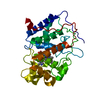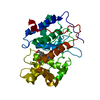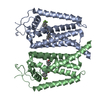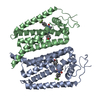+Search query
-Structure paper
| Title | Discovery and Optimization of Selective Brain-Penetrant EBP Inhibitors that Enhance Oligodendrocyte Formation. |
|---|---|
| Journal, issue, pages | J Med Chem, Vol. 67, Issue 6, Page 4819-4832, Year 2024 |
| Publish date | Mar 28, 2024 |
 Authors Authors | Ruth Dorel / Dawei Sun / Nicholas Carruthers / Georgette M Castanedo / Peter M-U Ung / Daniel C Factor / Tianbo Li / Hannah Baumann / Danielle Janota / Jodie Pang / Laurent Salphati / Robert Meklemburg / Allison J Korman / Halie E Harper / Samantha Stubblefield / Jian Payandeh / Daniel McHugh / Bradley T Lang / Paul J Tesar / Edward Dere / Matthieu Masureel / Drew J Adams / Matthew Volgraf / Marie-Gabrielle Braun /  |
| PubMed Abstract | The inhibition of emopamil binding protein (EBP), a sterol isomerase within the cholesterol biosynthesis pathway, promotes oligodendrocyte formation, which has been proposed as a potential ...The inhibition of emopamil binding protein (EBP), a sterol isomerase within the cholesterol biosynthesis pathway, promotes oligodendrocyte formation, which has been proposed as a potential therapeutic approach for treating multiple sclerosis. Herein, we describe the discovery and optimization of brain-penetrant, orally bioavailable inhibitors of EBP. A structure-based drug design approach from literature compound led to the discovery of a hydantoin-based scaffold, which provided balanced physicochemical properties and potency and an improved safety profile. The long half-lives of early hydantoin-based EBP inhibitors in rodents prompted an unconventional optimization strategy, focused on increasing metabolic turnover while maintaining potency and a brain-penetrant profile. The resulting EBP inhibitor demonstrated strong target engagement in the brain, as illustrated by the accumulation of EBP substrate zymostenol after repeated dosing. Furthermore, compound enhanced the formation of oligodendrocytes in human cortical organoids, providing additional support for our therapeutic hypothesis. |
 External links External links |  J Med Chem / J Med Chem /  PubMed:38470227 PubMed:38470227 |
| Methods | EM (single particle) |
| Resolution | 2.8 Å |
| Structure data | EMDB-43712, PDB-8w0r: EMDB-43713, PDB-8w0s: |
| Chemicals |  PDB-1aeu:  PDB-1aev: |
| Source |
|
 Keywords Keywords | ISOMERASE/INHIBITOR / Emopamil-Binding Protein Isomerization Protein structure complex / STRUCTURAL PROTEIN / ISOMERASE-INHIBITOR complex |
 Movie
Movie Controller
Controller Structure viewers
Structure viewers About Yorodumi Papers
About Yorodumi Papers







 homo sapiens (human)
homo sapiens (human)